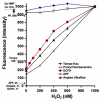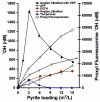Comparison of fluorescence-based techniques for the quantification of particle-induced hydroxyl radicals
- PMID: 18307787
- PMCID: PMC2289838
- DOI: 10.1186/1743-8977-5-2
Comparison of fluorescence-based techniques for the quantification of particle-induced hydroxyl radicals
Abstract
Background: Reactive oxygen species including hydroxyl radicals can cause oxidative stress and mutations. Inhaled particulate matter can trigger formation of hydroxyl radicals, which have been implicated as one of the causes of particulate-induced lung disease. The extreme reactivity of hydroxyl radicals presents challenges to their detection and quantification. Here, three fluorescein derivatives [aminophenyl fluorescamine (APF), amplex ultrared, and dichlorofluorescein (DCFH)] and two radical species, proxyl fluorescamine and tempo-9-ac have been compared for their usefulness to measure hydroxyl radicals generated in two different systems: a solution containing ferrous iron and a suspension of pyrite particles.
Results: APF, amplex ultrared, and DCFH react similarly to the presence of hydroxyl radicals. Proxyl fluorescamine and tempo-9-ac do not react with hydroxyl radicals directly, which reduces their sensitivity. Since both DCFH and amplex ultrared will react with reactive oxygen species other than hydroxyl radicals and another highly reactive species, peroxynitite, they lack specificity.
Conclusion: The most useful probe evaluated here for hydroxyl radicals formed from cell-free particle suspensions is APF due to its sensitivity and selectivity.
Figures



References
-
- Schoonen MAA, Cohn CA, Roemer E, Laffers R, Simon S, O'Riordan T. Mineral-induced formation of reactive oxygen species. In: Sahai N, Schoonen MAA, editor. Rev Min Geochem. Vol. 64. American Mineralogical Society; 2006. pp. 179–221. - DOI
-
- Donaldson K, Stone V, Borm PJA, Jimenez LA, Gilmour PS, Schins RPF, Knaapen AM, Rahman I, Faux SP, Brown DM, MacNee W. Oxidative stress and calcium signaling in the adverse effects of environmental particles (PM10) Free Radic Biol Med. 2003;34:1369–1382. doi: 10.1016/S0891-5849(03)00150-3. - DOI - PubMed
LinkOut - more resources
Full Text Sources
Other Literature Sources

